Through this systematic review of inputs including megatrends and smart grid driving forces, a set of potential scenarios and mini scenarios were developed that consider the impact on security of supply, economy, cybersecurity and safety for each situation.
- This article was first published in the CINELDI Annual Report 2019.
A mini scenario is a plausible event, development or action of significance for the future electricity distribution and can be combined in different ways to support or help understand main scenarios. Some mini scenarios have a clear negative or positive impact on the grid performance, whereas the impact of others is more uncertain.
Was it useful? The short answer is yes. More than 50% of CINELDI partners surveyed said they planned to use the results of this work in R&D strategy, company strategy, development of expertise or a strategy for pilots and demonstration projects. Several companies – especially grid operators – have already used the results.
Within CINELDI, the scenarios are now being used as a common base for other research, with the aim of reducing uncertainties in the development of a solid transition strategy towards a smart grid for Norway.
Specific mini scenarios proved valuable for all
The impact of the process surprised the team in several ways. Mini scenarios were expected to be one of the steps in developing the main scenarios, but they proved interesting in their own right for many stakeholders, both researchers and industrial representatives. The complexity of the main scenarios means that the much more specific mini scenarios were welcomed. They are now being used by industry and in other work packages because they highlight concrete examples of unique challenges and considerations.
"It seems now as if the main scenarios will become a tool for communication, to help set the centre's work in context and describe the future grid. It's the mini-scenarios that will provide the substance on which to build further research and transition planning," explains CINELDI Centre Director Gerd Kjølle.
A foresight process involving all actors
The team undertook a multidisciplinary foresight process including the most prominent technology providers in Norway, innovative grid operators, the Norwegian transmission system operator, research institutes, a university, energy authorities and market operators.
Why so many? The foresight process assumes that the future is not pre-determined and can evolve in different directions, which requires analysis from multiple perspectives. The process is therefore designed to capture reality and associated variables from more than one dimension. Foresight is not just about analysing the future, but also supporting the actors that will shape that future.
Driving forces: understanding the big picture first
Using various inputs, the process followed three steps: analysis and identification of driving forces, interpretation, and prospection. Gerd explains why the process begins with identifying and understanding driving forces:
"The needs of our society in the future will be dictated largely by megatrends and driving forces. A vast range of factors—human, technological, economic, regulatory—will impact the complexity of the smart grid, so we must consider all angles and all possibilities. Some factors drive development, some enable it, and others form barriers."
Once the driving forces were understood including all interconnections during the interpretation step, scenarios and mini scenarios were built to map potential futures in the prospection step. The scenarios are developed around plausible futures.
While the scenarios are now being used by other work packages, the experience of the foresight process will also be an important input to further work. "The transition strategy will integrate results from all CINELDI work packages. This is a complex field because of its multidisciplinary nature, so our positive experience of these foresight workshops is an important input when planning the next steps," says Tonje Skoglund Hermansen, who led the first part of the foresight process.
Selected mini scenarios
Here are just four examples from the more than 100 identified during the foresight process:
Information overload: Cheaper sensor devices lead to more measurement devices in the grid creating data overwhelm. The grid operator is unable to analyse all the data quickly enough leading to incorrect decision-making. This mini scenario would have a negative impact on security of supply, economy, and safety.
From peak power to stable loads: Electrified transport requires fast charging, creating a capacity challenge for the grid. Investments in onshore batteries results in stable load for the grid, and the ability for transport providers to support the grid in high load periods. This mini scenario would have a positive impact on security of supply and the economy.
Specialised competence: Grid operator recruitment is focused on specialised expertise in either ICT or electric power skills, which could result in a lack of interdependency understanding. Good ICT and electric power solutions are developed separately, but not coordinated. This mini scenario would have a negative impact on security of supply and the economy.
More offline microgrids: Distributed generation and neighbourhood microgrids reduce demand at the grid connection point. Several microgrids choose to go offline, which reduces the demand on the distribution grid further. This mini scenario would have an uncertain impact in all four areas: security of supply, economy, cybersecurity and safety.


